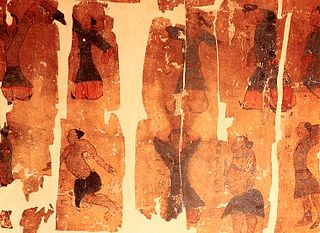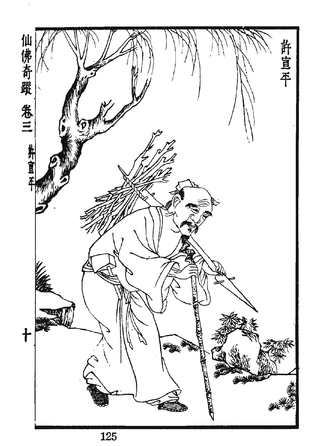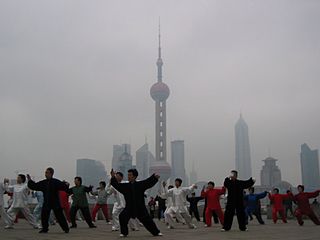
Neijia is the collective name for the internal Chinese martial arts. It relates to those martial arts occupied with spiritual, mental or qi-related aspects, as opposed to an "external" approach focused on physiological aspects. The distinction dates to the 17th century, but its modern application is due to publications by Sun Lutang, dating to the period of 1915 to 1928. Neijing is developed by using neigong or "internal changes", contrasted with waigong or "external exercises".

Tai chi is an internal Chinese martial art practiced for self-defense and health. Known for its slow, intentional movements, tai chi has practitioners worldwide and is particularly popular as a form of gentle exercise and moving meditation, with benefits to mental and physical health.

Shaolin kung fu, also called Shaolin Wushu, or Shaolin quan, is one of the oldest, largest, and most famous styles of wushu, or kung fu of Chan Buddhism. It combines Chan philosophy and martial arts. It was developed in the Shaolin Temple in Henan province, Greater China during its 1500-year history. Popular sayings in Chinese folklore related to this practice include "All martial arts under heaven originated from Shaolin" and "Shaolin kung fu is the best under heaven," indicating the influence of Shaolin kung fu among martial arts. The name Shaolin is also used as a brand for the so-called external styles of kung fu. Many styles in southern and northern China use the name Shaolin.

The Wudang Mountains are a mountain range in the northwestern part of Hubei, China. They are home to a famous complex of Taoist temples and monasteries associated with the Lord of the North, Xuantian Shangdi. The Wudang Mountains are renowned for the practice of tai chi and Taoism as the Taoist counterpart to the Shaolin Monastery, which is affiliated with Chan Buddhism. The Wudang Mountains are one of the "Four Sacred Mountains of Taoism" in China, an important destination for Taoist pilgrimages. The monasteries such as the Wudang Garden were made a UNESCO World Heritage Site in 1994 because of their religious significance and architectural achievement.

Daoyin is a series of cognitive body and mind unity exercises practiced as a form of Daoist neigong, meditation and mindfulness to cultivate jing (essence) and direct and refine qi, the internal energy of the body according to traditional Chinese medicine. These exercises are often divided into yin positions and yang positions. The practice of daoyin was a precursor of qigong, and was practised in Chinese Taoist monasteries for health and spiritual cultivation. Daoyin is also said to be a primary formative ingredient in the well-known "soft styles" of the Chinese martial arts, of tai chi, and middle road styles like Wuxingheqidao.
Zhang Wuji is the fictional protagonist of the wuxia novel The Heaven Sword and Dragon Saber by Jin Yong.

Xu Xuanping, was a Taoist hermit and poet of the Chinese Tang dynasty. He was said to have lived south of the Yangtze River in Huizhou. His legend relates that he left the city of Yangshan to become a recluse and build a home in Nan Mountain.

Huaquan is a Chinese martial art in the changquan family. It is believed to have originated during the Liu Song dynasty near Mount Hua in Shaanxi Province.
The Jiuyang Zhenjing, also known as the Nine Yang Manual, is a fictional martial arts manual in Jin Yong's Condor Trilogy. It was first introduced briefly at the end of the second novel The Return of the Condor Heroes. It plays a significant role in the third novel The Heaven Sword and Dragon Saber after Zhang Wuji discovers it and masters the skills in the book.

There are hundreds of different styles of Chinese martial arts, each with their own sets of techniques and ideas. The various movements in kung fu, most of which are imitations of the fighting styles of animals, are initiated from one to five basic foot positions: normal upright posture and the four stances called dragon, frog, horse riding, and snake.
Scott M. Rodell is a martial artist, author, and teacher of Yang-style taijiquan. He is the founding director of Great River Taoist Center, a non-profit organization based in Washington, D.C.

The tai chi classics are a collection of over 100 articles on the Chinese martial art of tai chi written by the art's master practitioners over the centuries. They cover everything from the underlying taiji philosophical principles, to methods of practice and application. Previously passed down in secret from generation to generation in whole or in parts through various lineages, they achieved classical status as they became public starting in the mid-1930s. Together they now serve as the single authoritative guide for the development and usage of tai chi skills. Written mostly in classical Chinese, they are used today mostly by the serious martial art practitioners of modern 6 Lineages that all trace their lineages to the ancient style taught by the Chen family and Yang family starting in the mid-19th century.
The Wudang School, sometimes also referred to as the Wu-Tang Clan, is a fictional martial arts school mentioned in several works of wuxia fiction. It is commonly featured as one of the leading orthodox schools in the wulin. It is named after the place it is based, the Wudang Mountains.

Chen Wangting (1580–1660), courtesy name Chen Zouting, was a Ming dynasty officer who may have founded Chen-style tai chi, one of the five major styles of the popular Chinese martial art. He reputedly devised his style of tai chi after his retirement following the fall of the Ming dynasty.

Tang Hao or Tang Fan Sheng (1887–1959) was a Chinese lawyer and expert on chinese martial arts.

Kung Fu Cult Master is a 1993 Hong Kong wuxia film adapted from Louis Cha's novel The Heaven Sword and Dragon Saber. Directed by Wong Jing, it featured fight choreography by Sammo Hung and starred Jet Li, Sharla Cheung, Chingmy Yau, and Gigi Lai in the lead roles.
Primordial qigong is a form of qigong purportedly developed by the Taoist sage Zhang Sanfeng. Also known as Wuji gong, it is said to have been developed by Zhang before he invented tai chi.

Wudangquan is a class of Chinese martial arts. In contemporary China, Chinese martial arts styles are generally classified into two major groups: Wudang (Wutang), named after the Wudang Mountains; and Shaolin, named after the Shaolin Monastery. Whereas Shaolin includes many martial art styles, Wudangquan includes only a few arts that use the focused mind to control the body. This typically encompasses tai chi, xingyiquan and baguazhang, but must also include bajiquan and Wudang Sword. Although the name Wudang distinguishes the skills, theories and applications of the internal arts from those of the Shaolin styles, these arts did not originate in the Wudang Mountains: the name Wudang comes from a popular Chinese legend that purports the genesis of tai chi and Wudang Sword by an immortal, Taoist hermit named Zhang Sanfeng who lived in the monasteries of Wudang Mountain. Wudang quan is often used synonymously with Neijia, but Neijia is a broader term that also encompasses Aikido and Qigong, which are not Wudang quan.

Alex Mieza, Taoist name Zi Xiao is an international master of traditional Chinese martial arts, Qigong and Internal Alchemy. Mieza represents Sanfeng Pai school of Wudang Taoism, China.













